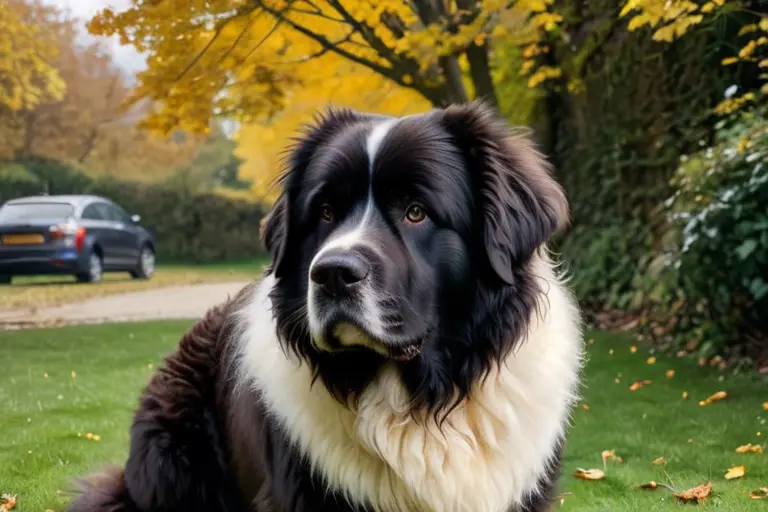Ever seen a dog so big it could practically walk shoulder-to-shoulder with a pony? Well, you might have just spotted a Landseer Newfoundland! These gentle giants are famous for their sweet nature and striking size. Whether you’re seriously thinking about bringing a Newfie into your life or just curious about these incredible dogs, let’s dive in and learn all about them!
Landseer Newfoundland Personality
Newfoundlands are often called “gentle giants” – and for good reason! These dogs are known for being incredibly calm, patient, and affectionate. They’re the kind of dog who loves to cuddle up on the couch with their families (though you might need a bigger couch than usual!). And don’t let their size fool you; Newfies are total softies at heart. They form incredibly strong bonds with their humans and are always eager to please.
While they might be gentle souls, Newfoundlands are also natural watchdogs. They’re always alert and will definitely protect their loved ones if they sense any danger. But don’t expect them to be barking up a storm at every little noise. Newfies tend to be on the quieter side—they prefer a good cuddle over a barking contest!
One of the best things about Newfoundlands is that they are intelligent and easy to train. They respond really well to positive reinforcement, so make sure you have plenty of treats and praise on hand! Starting training early is key, especially because Newfies have a bit of an extended puppyhood – they can be playful and boisterous for up to two years! Teaching them basic commands and manners from a young age will help them grow into well-adjusted gentle giants. And remember, even though they are big fluffballs, puppies can still be a bit rough, so make sure you teach them to play gently, especially with kids.
Landseer Newfoundland Appearance and Care:
If you’ve never seen a Landseer Newfoundland in person, get ready to be amazed! They’re big, strong, and have a dignified presence that makes them look like they’re always ready to pose for a portrait. They have these massive heads (seriously, they can reach an adult’s hip!), heavy bones, and sturdy legs that help them carry all that weight – they typically weigh between 100 and 150 pounds!
Now, let’s talk about that iconic Newfoundland coat! It’s thick, double-layered, and water-resistant, which makes sense considering they come from a place known for its chilly waters. They come in a few different colors: black, brown, gray, and even a striking black and white. And have you ever noticed their paws? They have webbed feet – a clue to their incredible swimming abilities!
Grooming a Landseer Newfoundland: A Labor of Love
Okay, let’s be real – owning a Landseer Newfoundland means you’re going to become very familiar with dog grooming! That double coat is beautiful but requires some serious upkeep. You’ll need to brush them regularly, two to three times a week, to prevent mats and tangles. And be prepared for shedding season (usually twice a year in the fall and spring) – you’ll be brushing daily to keep up with the “blowing coat.” A good brush, a comb, and maybe even an undercoat rake will be your best friends!
Besides brushing, Newfies need regular baths to keep their coat clean and smelling fresh. How often you bathe them depends on how much time they spend playing outdoors and how much dirt they track into the house (let’s just say it can be a lot!). And don’t forget those nails and ears – they need regular attention too.
Drool: The Newfoundland Quirk You’ll Learn to Love
Let’s talk about the elephant (or should we say, the Newfoundland) in the room: drool. Newfies are known for it! It’s just part of their charm. They tend to drool the most after eating and drinking, so keep a towel handy for quick cleanups. Some owners even use adorable bibs to catch the worst of it. Hey, we all have our quirks, right?
Making Space for a Newfie: Life With a Large Breed
Here’s the thing about Newfoundlands: they are big. And they need space to be happy and healthy. A home with a yard is ideal, but it’s not impossible to have a Newfie in an apartment if you are really committed to making sure they get enough exercise and mental stimulation. If you do live in an urban area, think about things like sidewalk etiquette (a big dog can be intimidating to some people), finding parks that welcome large breeds, and maybe even taking a training class to help your Newfie navigate city life.
While they might be large and in charge, Newfoundlands don’t need hours and hours of intense exercise. They’re actually pretty laid-back! A moderate amount of exercise – think about 30 minutes a day – is usually enough to keep them happy and healthy. Walks are great, and if you can find a safe spot for swimming, your Newfie will be in heaven! They’re natural swimmers – in fact, they do a breaststroke rather than a dog paddle! Just remember, even though they love the water, it’s crucial to teach them water safety to prevent accidents.

Landseer Newfoundland Health
It’s important to be upfront about the fact that Newfoundlands, like many large breeds, have a shorter lifespan than smaller dogs – they typically live 8 to 10 years. In that time, they grow incredibly fast, and that rapid growth can sometimes lead to health issues.
Some things to be aware of are:
- Orthopedic Problems: Hip and elbow dysplasia are common in Newfies. These are joint problems that can cause pain and arthritis.
- Heart Conditions: Newfoundlands are also prone to certain heart conditions, like dilated cardiomyopathy (an enlarged heart) and subaortic stenosis.
- Skin Issues: Skin and eyelid problems can also pop up in Newfies, so it’s important to keep an eye on their coat and skin health.
The good news is that there are things you can do to help your Landseer Newfoundland live a long, healthy life! Maintaining a healthy weight is crucial – it takes a lot of stress off their joints. Talk to your vet about the right diet and exercise plan for your Newfie. Regular vet checkups are a must – catching health problems early can make a big difference.
Training Your Landseer Newfoundland
Newfoundlands are eager learners, and they really want to make their humans happy. That makes training them a joy! The key is to start early and use positive reinforcement methods. Think: lots of praise, treats, and fun!
Since Newfies can grow to be quite large, teaching them leash manners is a top priority. Nobody wants to be dragged down the street by a giant fluffball! Crate training is also a good idea – it helps with housebreaking and provides your Newfie with a safe space of their own. And of course, mastering those basic obedience commands (sit, stay, come, down) is essential for any well-behaved dog.
Once your Newfie has mastered the basics, you can even explore advanced training options! Some Newfoundlands excel in agility, obedience competitions, rally, and even therapy dog work.
The History of These Amazing Dogs
So, where did these incredible dogs come from? Newfoundlands, as you might have guessed, are named after the Canadian province of Newfoundland, where they were originally bred as working dogs for fishermen. They would haul nets, cart wood, and even rescue people who had fallen overboard – pretty impressive, right?
Their history as water rescue dogs is legendary! They have this amazing ability to swim long distances and even tow people back to shore. It’s no surprise that they were once required companions for lifeguards in England and Wales.
Is a Landseer Newfoundland Right for You?
Newfoundlands are truly amazing dogs, but they’re not the right fit for everyone. Before you rush out to find a Newfie breeder, take some time to consider if you can provide the space, time, and resources these gentle giants need. If you can, you’ll be rewarded with a loyal, loving, and utterly charming companion who will bring joy to your life for many years to come.
If you decide a Newfoundland is the right breed for you, make sure you find a reputable breeder. You want a breeder who is committed to ethical breeding practices and who prioritizes the health and well-being of their dogs. Another option is to consider adopting a Newfoundland from a rescue organization – there are many wonderful Newfies out there looking for their forever homes!








